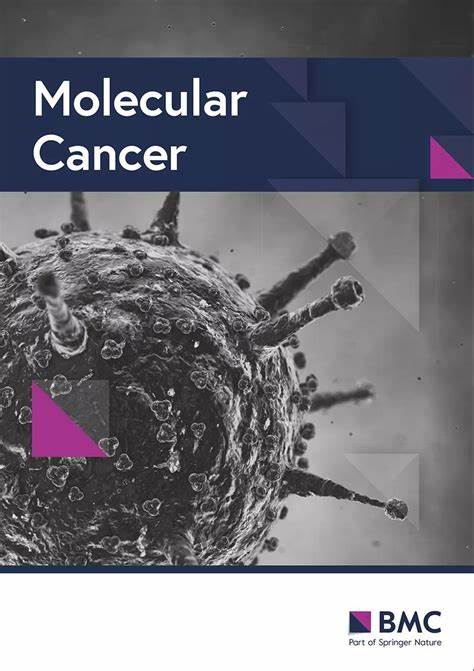A circRNA promotes esophageal squamous cell carcinoma progression by inhibiting TRIM25-mediated degradation of IGF2BP family members
IF 33.9
1区 医学
Q1 BIOCHEMISTRY & MOLECULAR BIOLOGY
引用次数: 0
Abstract
Esophageal squamous cell carcinoma (ESCC) is a highly aggressive malignancy with poor prognosis and limited treatment options. While circular RNAs (circRNAs) are frequently dysregulated in ESCC, their functional roles and molecular mechanisms in tumor progression remain largely unexplored. We characterized circRNA using RT-PCR, Sanger sequencing, and fluorescent in situ hybridization. Gain- and loss-of-function studies in vitro and in vivo were performed to assess circRNA function. Molecular interactions were investigated via RNA pull-down assays coupled with mass spectrometry, electrophoretic mobility shift assays, co-immunoprecipitation, and immunoblot analysis. Clinical relevance was evaluated by RT-qPCR and immunohistochemistry in patient specimens. We identified circLNF, a novel circRNA derived from the long non-coding RNA FIRRE gene, which is significantly upregulated in ESCC. Functional assays demonstrated that circLNF promotes proliferative and migratory capacities in cultured cells and accelerates tumor progression and metastasis in animal models. Mechanistically, circLNF directly interacts with IGF2BP family proteins through their “CAUC” motifs, protecting them from TRIM25-mediated ubiquitination and proteasomal degradation. Importantly, circLNF expression positively correlated with IGF2BP1 protein levels in ESCC patient tissues, underscoring the clinical relevance of the circLNF-IGF2BP axis in ESCC progression. Our findings reveal an oncogenic role of circLNF in ESCC by inhibiting TRIM25-mediated proteasomal degradation of IGF2BP proteins and highlight circLNF as a potential therapeutic target for ESCC.circRNA通过抑制trim25介导的IGF2BP家族成员降解促进食管鳞状细胞癌的进展
食管鳞状细胞癌(ESCC)是一种高度侵袭性的恶性肿瘤,预后差,治疗方案有限。虽然环状rna (circRNAs)在ESCC中经常失调,但它们在肿瘤进展中的功能作用和分子机制在很大程度上仍未被探索。我们使用RT-PCR、Sanger测序和荧光原位杂交来表征circRNA。在体外和体内进行了功能获得和功能丧失研究,以评估circRNA的功能。分子间的相互作用通过RNA下拉法、质谱法、电泳迁移位移法、共免疫沉淀和免疫印迹分析来研究。通过患者标本的RT-qPCR和免疫组织化学评估临床相关性。我们鉴定出circLNF,这是一种源自长链非编码RNA FIRRE基因的新型环状RNA,在ESCC中显著上调。功能分析表明,在动物模型中,circLNF促进培养细胞的增殖和迁移能力,并加速肿瘤的进展和转移。从机制上讲,circLNF通过IGF2BP家族蛋白的“CAUC”基元直接与它们相互作用,保护它们免受trim25介导的泛素化和蛋白酶体降解。重要的是,在ESCC患者组织中,circLNF表达与IGF2BP1蛋白水平呈正相关,强调了circLNF- igf2bp轴在ESCC进展中的临床相关性。我们的研究结果揭示了circLNF通过抑制trim25介导的IGF2BP蛋白的蛋白酶体降解在ESCC中的致癌作用,并强调了circLNF作为ESCC的潜在治疗靶点。
本文章由计算机程序翻译,如有差异,请以英文原文为准。
求助全文
约1分钟内获得全文
求助全文
来源期刊

Molecular Cancer
医学-生化与分子生物学
CiteScore
54.90
自引率
2.70%
发文量
224
审稿时长
2 months
期刊介绍:
Molecular Cancer is a platform that encourages the exchange of ideas and discoveries in the field of cancer research, particularly focusing on the molecular aspects. Our goal is to facilitate discussions and provide insights into various areas of cancer and related biomedical science. We welcome articles from basic, translational, and clinical research that contribute to the advancement of understanding, prevention, diagnosis, and treatment of cancer.
The scope of topics covered in Molecular Cancer is diverse and inclusive. These include, but are not limited to, cell and tumor biology, angiogenesis, utilizing animal models, understanding metastasis, exploring cancer antigens and the immune response, investigating cellular signaling and molecular biology, examining epidemiology, genetic and molecular profiling of cancer, identifying molecular targets, studying cancer stem cells, exploring DNA damage and repair mechanisms, analyzing cell cycle regulation, investigating apoptosis, exploring molecular virology, and evaluating vaccine and antibody-based cancer therapies.
Molecular Cancer serves as an important platform for sharing exciting discoveries in cancer-related research. It offers an unparalleled opportunity to communicate information to both specialists and the general public. The online presence of Molecular Cancer enables immediate publication of accepted articles and facilitates the presentation of large datasets and supplementary information. This ensures that new research is efficiently and rapidly disseminated to the scientific community.
 求助内容:
求助内容: 应助结果提醒方式:
应助结果提醒方式:


